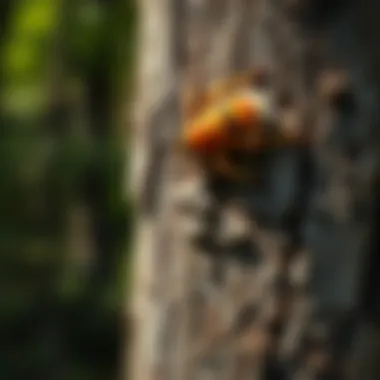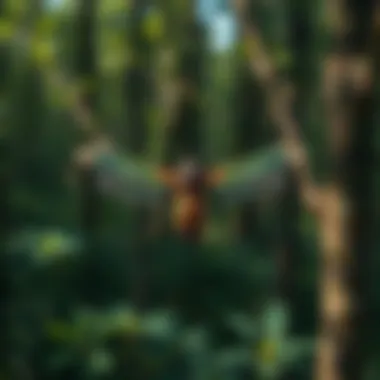Understanding Insect Damage in Woodland Stewardship


Intro
Insects are a fact of life in any woodland ecosystem, both as friends and foes. While they play essential roles in pollination and decomposition, some species can be downright destructive, jeopardizing the delicate balance of our forests. Understanding how insect damage manifests, the importance of biodiversity, and sustainable management strategies becomes critical for maintaining healthy woodlands. This knowledge not only aids forestry professionals but also empowers nature enthusiasts to contribute to the stewardship of these vital ecosystems.
With the gradual impact of climate change and rising human interference, the shift in insect dynamics has far-reaching consequences. In the sections to follow, we will examine detailed aspects of woodland ecosystems and how insect activity can influence their health. It outlines strategies for managing these challenges, ensuring a sustainable future for our forests.
Understanding Woodland Ecosystems
Woodland ecosystems are a patchwork of life, rich with biodiversity that supports a plethora of species. Each organism, from the tallest tree to the tiniest beetle, contributes to a larger narrative of interaction and balance. Let’s delve into two crucial facets of woodland ecosystems that are often overlooked:
Importance of Biodiversity in Forests
Biodiversity serves as the backbone of forest ecosystems. Numerous studies indicate that a higher level of species diversity leads to greater ecosystem functionality. For instance, different tree species can host various insects, some of which might be beneficial, while others can be harmful.
- Mutualism: Certain insects assist in the distribution of seeds and pollination, supporting the growth of diverse plant life.
- Food Web Stability: A diverse mix of species ensures that ecosystems are resilient to disease and environmental changes.
This diversity prompts forest complexity, which enhances their ability to withstand the pressures of invasive species or pathogens.
Role of Forests in Climate Regulation
Forests play a significant role in mitigating climate change by sequestering carbon from the atmosphere. Healthy, biodiverse forests offer a kind of natural air conditioner. Many forestry professionals emphasize the dual role of trees in climate regulation and habitat preservation. Here are some key functions:
- Carbon Storage: Trees absorb carbon dioxide, helping to lessen the impacts of greenhouse gas emissions.
- Microclimate Regulation: Forests can stabilize local climates by reducing temperature fluctuations and humidity variations.
In light of the challenges posed by climate change, it's critical to appreciate the importance of preserving these ecosystems not only for their resources but also for the climatic balance they provide.
"The intricate tapestry of life in woodland ecosystems relies heavily on the synergy between various species, making every piece important in the grand scheme of things."
Sustainable Forestry Practices
Sustainable forestry is not merely a buzzword; it's a necessity for preserving woodland ecosystems. By understanding the principles and practices, we can manage forests in a way that ensures their health for generations to come.
Principles of Sustainable Forestry
Sustainable forestry focuses on maintaining ecological integrity while providing necessary resources. This encompasses:
- Selective Logging: Harvesting only specific trees can help maintain biodiversity and reduce damage to the surrounding habitat.
- Ecosystem Monitoring: Continuous assessment of forest health informs better management decisions and timely interventions.
Case Studies of Successful Implementations
There are several documented cases showcasing sustainable forestry in action:
- The Heartwood Initiative: A project in the United Kingdom that uses community engagement to manage local forests sustainably.
- Tropical Forest Foundation: This group focuses on reforestation efforts that prioritize native species, contributing to biodiversity resilience.
These examples highlight the real-world applicability of sustainable practices, revealing that stewardship can go hand in hand with resource utilization.
Woodland Stewardship Techniques
Stewardship isn't just about watching over our forests; it requires active engagement, planning, and intervention to ensure ecological health.
Forest Management Plans
Creating a detailed forest management plan is essential. Such a plan typically involves:
- Setting Clear Objectives: What are the primary goals? Harvesting, conservation, or recreation?
- Insect Monitoring Protocols: Regular assessments can identify potential threats before they escalate.
Conservation Strategies
Conservation is at the heart of effective woodland stewardship. Strategies include:
- Creating Wildlife Corridors: These allow for safe movement of animal species, promoting genetic diversity.
- Community Engagement Programs: Educating the public about forest ecosystem health can foster a culture of stewardship.
Preface to Insect Damage
In the realm of forestry, understanding insect damage is akin to having a compass in an unpredictable storm. Insects, often overlooked, carry the power to alter the course of woodland health significantly. Recognizing the types of damage and its implications not only helps in crafting effective management strategies but also underscores the intricate web of life residing within our forests. Through this exploration, forestry professionals will grasp the vital connection between insect behavior and the sustainability of woodland ecosystems.
Definition of Insect Damage
Insect damage refers to the detrimental effects caused by insects on plant life, particularly trees in forested areas. These impacts can stem from various behaviors: feeding, burrowing, or even spreading diseases. When insects invade, they don’t just harm a single tree; they can throw whole ecosystems into disarray. This damage can lead to tree mortality, diminished growth rates, and a decline in overall forest health. For instance, bark beetles, which compromise the protective outer layers of trees, can allow opportunistic pathogens to thrive, exacerbating the situation.
While the effects of insect damage can often be visible—like wilting leaves or dead branches—the underlying issues may be more complex. Different insects might target different species or structural parts of a tree, showcasing a diverse array of impacts.


Historical Context
Historically, the relationship between trees and insects is as old as the forests themselves. Native Americans understood the significance of managing insect populations even before the science of entomology came into play. They practiced selective harvesting and other cultural practices to maintain forest balance. However, modern forestry approaches often overlook these traditional methods.
The last century has witnessed a surge in technology and industrial practices that sometimes disregard the delicate equilibrium in forest ecosystems. Events such as the catastrophic infestations of mountain pine beetles in the late 20th century serve as stark reminders of the consequences of neglect. This situation highlighted how invasive species can devastate extensive areas if not managed correctly. Furthermore, climate change increasingly plays a role by altering habitats, extending insect lifecycles, and allowing pests to thrive beyond their typical ranges.
"Insect damage isn't just a forestry issue; it's a matter of ecological stability. Understanding this can pave the way for more sustainable practices."
In summary, recognizing what insect damage is and exploring its historical context offers profound insights into how we can approach woodland stewardship today. As we delve deeper into the types of insects causing damage, understanding these foundational elements will help shape more informed, proactive strategies for preservation.
Types of Insects Causing Damage
Understanding the role insects play in damaging woodland ecosystems is not merely an academic exercise; it's a crucial component for anyone engaged in forestry or eager to appreciate nature's complexities. The variety of insects that cause damage is extensive, each contributing uniquely to the woodland's health or decline. These insects can lead to significant tree stress, promote the spread of disease, and alter ecosystems. Grasping the nuances of these insect groups helps professionals and enthusiasts alike form better management strategies, fostering healthier woodlands.
Bark Beetles
Bark beetles are a notorious group, often recognized by their ability to bore through tree bark and feed on the inner layers. This behavior isn't just a minor nuisance; it can lead to wide-scale tree mortality within forests. In particular, the mountain pine beetle has made headlines due to its devastating impact on conifer populations across North America. Once they invade, they can disrupt the tree's nutrient flow, effectively choking it off from water and sugars, leading to its slow demise.
The identification of bark beetles is crucial for effective management. Their presence can often be detected through signs such as pitch tubes, frass, or dead sections of trees. Monitoring and controlling bark beetle populations can save vast areas of forest. A common strategy is the use of pheromone traps to capture these pests and reduce their numbers. Management practices focused on improving tree vigor can also help trees resist attack by these beetles, providing a dual benefit of sustaining the forest ecosystem while ensuring economic stability for timber industries.
Leaf Miners
Leaf miners, as their name implies, create winding pathways or clear blotches of damage on leaves as they feed between the layers. This might seem like a minor issue, but when infestations occur, the cumulative effect can be quite detrimental. In extreme cases, entire leaf canopies may be affected, leading to reduced photosynthesis and, consequently, tree health.
Identification of leaf miners involves looking for the tell-tale signs of their activity on foliage. Different species target various tree types, and understanding which leaf miners are present can help tailor management strategies. Organic and integrated pest management techniques can be effective for controlling their populations without resorting to broad-spectrum insecticides.
Wood Borers
Wood borers are often the silent destroyers of forests, as their damage often occurs below the surface. These insects tunnel through wood, weakening the structural integrity of trees over time. Some species, such as the Asian longhorned beetle, can decimate hardwood forests, while others may specifically target certain types of trees. The damage can take years to manifest, leading to delayed recognition and response.
The importance of monitoring wood borers cannot be overstated. Regular inspections of trees, especially aging or stressed specimens, can help detect early signs of boring. In some cases, removing infested wood can halt the spread to nearby healthy trees, serving as a key prevention tactic.
Foliage Feeding Insects
Foliage feeding insects encompass a broad range of pests including caterpillars and certain beetles, which feast on the leaves, creating conspicuous holes and defoliating trees. Although some trees can withstand partial feeding, extensive foliage damage can cause trees to become stressed. This stress not only leaves them more vulnerable to diseases but can also diminish their growth rate and reproductive success.
Effective management usually revolves around monitoring environments for changes in insect populations, especially during the growing season when these pests are most active. This can involve scouting trees and employing natural predatory insects, thus introducing a balanced approach to maintaining woodland health.
"Managing woodland health requires understanding the complex interactions between insects and trees, and recognizing that some insects can both harm and help ecosystems."
Ecological Impact of Insect Damage
Insects play a crucial role in the health and stability of woodland ecosystems. However, when these creatures deviate from their natural behaviors and begin causing damage, the consequences can ripple throughout the environment. Understanding the ecological impact of insect damage helps to inform sustainable forestry practices and woodland stewardship efforts. This section will explore how insect damage affects tree health, biodiversity within the ecosystem, and the overall integrity of soil and water systems.
Effects on Tree Health
Insect damage can manifest in various ways, each leading to significant consequences for tree health. Bark beetles, for example, not only feed on tree bark but also introduce pathogens that compromise the tree's ability to transport nutrients. When a tree is under attack, it may show signs of wilting, discoloration, or even premature leaf drop. Healthy trees are essential for carbon sequestration, oxygen production, and providing habitat for many woodland species. When tree health declines, entire forests can become more susceptible to disease, the influence of secondary pests, and even increased mortality rates. Supporting tree vitality is thus paramount in any woodland stewardship agenda.
Biodiversity Consequences
The impact of insect damage extends beyond individual trees and impacts the broader ecosystem, particularly biodiversity. The decline in tree health can lead to habitat loss for various species that depend on these trees for food and shelter, creating a cascading effect throughout the food web. For example, sap-sucking insects may thrive when particular trees die, and their increased population could outcompete other beneficial insects. This imbalance can result in fewer species in the forest, ultimately reducing the ecosystem’s resilience.
In a healthy woodland, variety is the spice of life. However, the loss of specific trees can tip the scales leading to diminished biodiversity.
As various species struggle to adapt to rapid and unfavorable changes, this shift can set off a domino effect that touches the entire ecosystem, affecting everything from birds to soil organisms.
Soil and Water Systems
Insect damage also has profound effects on soil and water systems essential for maintaining forest health. Healthy trees play a pivotal role in soil stabilization and nutrient cycling. When insect infestations weaken or kill a tree, it can lead to increased soil erosion and degradation. This poses a risk to water quality as sediments can wash into streams and rivers, impacting aquatic life. Moreover, as trees die and decay, they release nutrients at an accelerated rate, which can initially lead to a short-term increase in fertility but eventually can disturb the delicate balance, leading to nutrient leaching.
Caring for the trees and monitoring insect populations helps maintain the integrity of soil structure and water systems, ensuring that these natural resources remain healthy for future generations.
As we navigate the complex interrelations of woodland ecosystems, understanding the impacts of insect damage becomes evident. Protecting trees means preserving life and function in the entire ecosystem. This knowledge is vital for forestry professionals and conservationists alike.
Detection and Monitoring Methods
Understanding insect damage is crucial for maintaining woodland health, and effective detection and monitoring methods form the backbone of any successful management strategy. These methods not only allow for early intervention but also help in assessing the extent of damage, informing future actions. Monitoring can be thought of as the first line of defense against insect infestations. By spotting problems before they spiral out of control, woodland stewards can implement timely, effective measures. The methods we discuss here can be divided broadly into visual inspection techniques, use of traps and lures, and advanced remote sensing applications.
Visual Inspection Techniques
Surveys conducted through visual inspection might seem old-fashioned, yet they remain a fundamental approach to scouting for insect activity. This technique involves checking trees for signs of damage such as dieback, insect exit holes, or bore dust.
Trained personnel can quickly recognize patterns that might be indicative of specific insect pests. For example, the intricate galleries formed by bark beetles are a telltale sign of trouble. While this approach requires trained eyes, it offers several benefits:


- Immediate feedback: Inspectors can instantly note down any signs of insect activity.
- Cost-effective: Visual inspections generally do not require specialized equipment, making them accessible to a wide range of forestry professionals.
- Ecosystem understanding: Observing the woodland allows for greater insight into the overall health of the ecosystem.
It’s vital, however, to remain cautious; inexperienced personnel may overlook subtle signs of damage, leading to delayed responses.
Traps and Lures
Traps and lures take insect monitoring to the next level. By using pheromones or visual cues that attract specific insect species, these tools provide quantitative insight into infestations. Each trap type has its strengths: sticky traps, for instance, efficiently collect insects, while bait traps are often targeted to lure particular pests.
Advantages include:
- Targeted monitoring: Different traps can help track specific species, allowing stewards to address issues more precisely.
- Quantitative data: The catch count provides valuable data that can help gauge infestation levels over time.
Nevertheless, it’s important to consider the placement and timing of these traps. Misjudging these factors might lead to skewed results, rendering your monitoring efforts less effective.
Remote Sensing Applications
The advent of technology has brought remote sensing applications into the realm of forestry monitoring. Utilizing aerial surveys and satellite images can uncover extensive damage that might not be visible from the ground. With the ability to analyze vast areas quickly, remote sensing aids in:
- Early detection: Changes in leaf coloration or canopy structure can signal insect stress before visible signs occur.
- Extensive coverage: It's possible to monitor large, inaccessible woodland areas, ensuring no problems go unnoticed.
Effective monitoring is the backbone of woodland health management, enabling proactive responses to insect damage before it exacerbates.
In sum, understanding the interplay of these methodologies helps in creating a sustainable woodland stewardship plan that guards against the threats posed by insect damage.
Management Strategies for Insect Damage
The management of insect damage in woodlands is akin to navigating a tightrope. It involves a careful balance between protecting tree health and fostering an ecosystem where both flora and fauna can thrive. As forestry professionals delve into this subject, they must consider not just the immediate effects of insect infestations but also the long-term implications for biodiversity and ecosystem stability. Understanding management strategies offers invaluable benefits: they can mitigate damage, enhance forest resilience, and ensure sustainable forestry practices that benefit future generations.
Preventive Approaches
Prevention is often more cost-effective than remedying damage once it occurs. Various preventive measures can be employed to create an inhospitable environment for pests while promoting tree health. For instance:
- Planting Resilient Species: Choosing native and resistant tree species can significantly reduce vulnerability.
- Site Selection: Assessing soil, climate, and other environmental factors before planting can minimize future risks.
- Regular Monitoring: Keeping a keen eye on tree health and early signs of insect activity allows for prompt intervention.
- Cultural Practices: Implementing practices such as thinning stands and proper spacing can reduce competition and support the trees’ growth.
These strategies are not merely preventative but also proactive, creating a self-sustaining woodlands ecosystem.
Chemical Treatments
When preventive methods fail, chemical treatments may be necessary. However, these need to be utilized wisely to avoid disrupting the delicate balance of the ecosystem. Various types of treatments can be used:
- Insecticides: Targeted chemicals can effectively manage specific pests. Pyrethroids are among the popular choices; they disrupt the nervous system of insects, offering quick control.
- Systemic Treatments: Chemicals absorbed by trees can provide internal protection against pests. For instance, imidacloprid can be applied to combat bark beetles.
- Fungicides: Sometimes, pests bring along pathogens, so fungal treatments may be required to protect weakened trees.
Nonetheless, caution is essential. Over-reliance on chemical solutions can lead to resistance among pest populations and adverse effects on non-target species, including beneficial insects like pollinators.
Biological Control Methods
Biological control methods present an alternative to chemical interventions, harnessing natural enemies to manage insect populations. This approach is often sustainable, with less risk to the ecosystem. Some examples include:
- Beneficial Insects: Introducing predators—like ladybugs for aphids or parasitic wasps for caterpillars—can naturally reduce pest numbers.
- Microbial Insecticides: These include products derived from bacteria, fungi, or viruses. For example, Bacillus thuringiensis (Bt) can target specific insect larvae without harming other organisms.
- Habitat Manipulation: Enhancing habitats for beneficial organisms creates a supportive environment for natural pest control.
This interplay between species not only manages pests but also enriches the woodland's biodiversity.
The key takeaway is that an integrated approach, combining preventive, chemical, and biological methods, tends to be the most effective strategy for managing insect damage in woodlands.
In essence, the management strategies for insect damage should not be viewed as isolated tactics, but rather as part of a broader strategy of woodland stewardship. By understanding and applying these approaches thoughtfully, forestry professionals can ensure the longevity and health of our precious ecosystems.
Role of Insects in Ecosystem Balance
Insects often hold the keys to maintaining harmony within ecosystems. Their role may sometimes get overshadowed by the more noticeable larger fauna and flora, yet insects provide essential functions that ensure woodland health. By balancing populations and facilitating vital ecological processes, insects play a critical role worth understanding for anyone engaged in woodland stewardship.
Pollination Effects
Pollination is perhaps one of the most celebrated roles insects fulfill in ecosystems. Various insect species, such as bees, butterflies, and beetles, are crucial in the reproductive processes of numerous plant species. When insects visit flowers to gather nectar, they incidentally transfer pollen from one blossom to another. This simple act allows plants to reproduce, forming a foundation for the entire forest ecosystem.
Notably, over 75% of the world's flowering plants depend on animal pollinators. This includes many crops essential for human consumption. However, not all pollinators are created equal. Insects like honeybees can efficiently cover vast areas, while others might favor specific local flora, showcasing the need for a diverse insect population. To put it simply, a decline in insect populations can lead to catastrophic ripple effects through the ecosystem, directly impacting food sources for a plethora of species, including humans.
Decomposition Processes
Another significant contribution of insects lies in their role in the decomposition processes. Decomposers, such as ants and certain beetles, are nature’s clean-up crew. They break down dead plant material, fallen leaves, and carrion, turning potentially wasteful material into nutritious organic matter. By doing so, they convert this matter into humus, which is essential for soil fertility.
For instance, termites are notorious for breaking down wood, recycling nutrients back into the soil. If this decomposition process were to stall due to a decline in insect populations, nutrient cycling could be severely disrupted, leading to poorer soil health. A healthy ecosystem relies not only on the presence of living organisms but also on the efficient recycling of materials through decomposition.


"Without the humble insect, the world would be buried under organic waste, with little chance to replenish the soil.”
Nutrient Cycling
Beyond simple decomposition, insects significantly influence nutrient cycling within ecosystems. As they consume organic materials, insects play a role in redistributing nutrients through their feces, which often contains elements essential for plant growth, like nitrogen and phosphorus.
Moreover, the interactions between insects and soil microbes can enhance nutrient bioavailability. Certain insects facilitate the movement of nutrients closer to plant roots, making it easier for vegetation to absorb them. A well-balanced insect community is, therefore, critical to sustaining soil quality and ensuring that forests can flourish over time.
In sum, understanding the roles of insects within ecosystems is vital for effective woodland stewardship. Their contributions to pollination, decomposition, and nutrient cycling illustrate a complex interplay that supports the health of our woodlands. All forestry professionals must recognize and advocate for the conservation of insect populations, as their loss could lead to a domino effect, resulting in a drastically altered environment.
Case Studies in Insect Damage
The study of insect damage in woodlands is not merely an academic exercise; it provides real-world insights into how these pests influence forest ecosystems. Case studies offer a window into the spectrum of effects insect infestations can have, serving as important markers for understanding broader ecological and management implications. By zeroing in on specific examples of insect damage, we can appreciate the nuances at play and derive lessons for future woodland stewardship. Let's dive into two prominent cases: the Mountain Pine Beetle and the Ash Borer.
Impact of the Mountain Pine Beetle
The Mountain Pine Beetle, known scientifically as Dendroctonus ponderosae, has wreaked havoc across vast swathes of North America's forests. This little pest is much more than just a nuisance; it represents a quintessential case of how an insect can reshape an entire ecosystem.
Initially, its impact is somewhat stealthy, as the beetle invades the bark of pine trees. The beetles burrow beneath the surface and lay their eggs, spending the larval stage just munching away at vital tree tissue. As they proliferate, the tree's defenses weaken, eventually leading to its decline and death.
The sequence of events is significant:
- Epidemic Outbreaks: Understanding the patterns of outbreaks helps foresters anticipate necessary management practices.
- Forest Fire Risks: Dead trees can become kindling for wildfires, making forest management crucial in affected areas.
- Economic Considerations: The timber industry takes a hit when large numbers of trees die.
Faced with an outbreak, forest managers need to be proactive, assessing the scale of damage and implementing control measures. Restoring balance necessitates not just understanding the beetle itself but also the broader ecological community it disrupts.
“The Mountain Pine Beetle is more than a pest; it’s a transformative force in the ecosystem.”
Ash Borer Infestation Analysis
Moving eastward, we encounter the Emerald Ash Borer (Agrilus planipennis), a glittering green beetle that has devastated ash populations across the United States. This insect arrived from Asia, and its ability to lay waste to entire species within a few years speaks to its destructive power.
The analysis of the Ash Borer's spread offers critical insights:
- Species Losses: Ash trees play a significant role in many ecosystems. Their removal alters habitats, affecting everything from insects to birds.
- Economic Ramifications: The decline of valuable timber species can impact local economies dependent on wood products.
- Forest Dynamics: As ash trees die out, the understory may change, leading to a shift in plant species and potentially invasive species taking hold.
Each case offers its own set of management challenges. Understanding the ecology around these infestations helps in crafting targeted responses. Forest stewardship is not just about combating a pest but rather navigating a changing landscape filled with complex ecological interactions.
In both instances, these case studies underscore the need for a nuanced approach to woodland management, highlighting the importance of flexibility and adaptation in the face of insect threats.
Future Research Directions
The theme of future research in the realm of insect damage and woodland stewardship isn’t just academic; it holds practical implications for forest management and ecological balance. This area invites inquiries into how we can leverage emerging technologies and methodologies to enhance our understanding and response to insect dynamics. The modern world is experiencing rapid advancements in monitoring technologies, which can unveil deeper insights and foster proactive management strategies. The foresight we cultivate today in research will inevitably shape the forest ecosystems of tomorrow.
Integrating Technology in Monitoring
Adopting technology in monitoring insect populations paves the way for sophisticated approaches, making it easier for forestry professionals to gather data and respond effectively to issues as they arise. For instance, remote sensing technologies, like satellite imagery, can reveal large-scale patterns of insect infestations that ground-level inspections might miss. Drones have emerged as a valuable tool, providing aerial views of forest health that allow for efficient mapping of tree damage and identifying affected areas distinctly.
- Automated Traps and Sensors: By employing smart traps equipped with sensors, real-time data can be transmitted concerning insect activity, potentially minimizing the lag time between detection and intervention.
- Predictive Modeling: Utilizing data analytics and machine learning offers predictive insights on the likely spread and impact of infestations. Such models can incorporate environmental factors, historical data, and behavioral patterns to anticipate pest outbreaks.
Utilizing these technologies not only improves monitoring efficiency but also enhances our predictive capabilities, allowing stewardship efforts to be more proactive instead of reactive. Moreover, it can lead to better allocation of resources, focusing on high-risk areas before infestations escalate.
Long-term Ecological Studies
Long-term studies are essential for understanding the consequences of insect damage across different temporal scales. Insect dynamics are fluid, responding to climatic variations, changes in forest management practices, and alterations in biodiversity. It is crucial to assess these patterns over time, recognizing that short-term observations might miss key relationships.
- Impact Assessment: Longitudinal studies would capture how insect damage affects not only the trees but also the broader woodland ecosystem, including changes in species composition and the health of soil and water systems.
- Adaptive Management: By gathering extensive data over years, researchers can identify trends and adapt management practices accordingly. This data-rich environment helps refine strategies for sustainability, ensuring forest resilience amidst changing ecological pressures.
- Ecological Interventions: Long-term research can reveal the potential benefits of varying interventions, from chemical control to biological management, comparing their effectiveness over time.
Such rigorous ecological studies lay a framework that informs not only immediate practices but also long-term preservation goals. It emphasizes the need for an integrative approach where ecological, technological, social, and economic factors converge in understanding and addressing insect damage. By fostering this collaborative research avenue, woodland stewardship can evolve to meet the challenges posed by insect dynamics while conserving forest health for future generations.
End: The Necessity of Awareness
In the delicate tapestry of woodland ecosystems, the role of insect damage cannot be understated. Understanding this subject is not merely an academic pursuit; it’s a vital endeavor for anyone involved in forestry management and woodland stewardship. The impacts of insects—both damaging and beneficial—shape the health and sustainability of forested areas. Consequently, fostering a deep awareness of these dynamics becomes imperative for effective stewardship practices.
Encouraging Woodland Stewardship
Woodland stewardship hinges on balanced ecosystem management. This includes recognizing the signs of insect damage early, implementing preventive strategies, and actively participating in habitat restoration. Sustainable forestry practices help maintain ecological balance, benefiting a myriad of species, including humans, who rely on these areas for resources and recreation.
- Holistic Awareness: It’s essential to look beyond the immediate effects of insect damage; consider long-term ecological health. Understanding the specific insects at play, such as bark beetles or leaf miners, can allow professionals to respond effectively.
- Community Involvement: Engaging local communities in stewardship efforts promotes awareness. Educational programs can emphasize the importance of insect roles in the ecosystem, nurturing a sense of responsibility among residents.
- Policy Advocacy: Woodland professionals should advocate for policies that support biodiversity conservation. This can include funding for research on pest management and public funds for preserving native habitats.
By encouraging diverse approaches to woodland stewardship, we foster resilience against the myriad challenges posed by insect damage, creating a healthier forest ecosystem.
Implications for Future Forestry Practices
As we project into the future, the implications of insect damage on forestry practices become increasingly clear. Climate change and urban encroachment are altering insect populations and behaviors, necessitating adaptive management strategies. Understanding these influences is key to future-proofing forestry practices.
- Adaptive Management: Practices must become flexible, allowing for quick adjustments as insect behavior patterns evolve. Continuous research can inform these changes, ensuring practices remain relevant amidst shifting ecological contexts.
- Innovation in Technology: Embracing new technologies for monitoring insect populations can lead to better-informed management decisions. For instance, using remote sensing to detect infestations offers a proactive approach rather than a reactive one.
- Emphasis on Resilience: Future forestry practices must prioritize the resilience of forest ecosystems. Incorporating diverse species into woodlands can mitigate the risk of widespread insect damage, promoting a varied habitat that supports not only trees but also wildlife.
Awareness leads to action. Recognizing the implications of insect damage is foundational for effective woodland stewardship and sustainable forestry practices.







